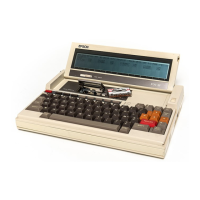Appendix
E
ASCII
CODE
TABLEANDINTERNA-
TIONAL
CHARACTER
SETS
E-l
ASCII codes and setting international character sets
Since a computer and its associated peripheral devices are essentially numerical
machines, in order
to
produce
"human
readable" output, either
on
a screen
or
printer, there has
to
be a code relating the alphanumeric characters to the
numbers the computer uses. This code has been standardised so
that
different
computer, printers etc., produce the correct output. The standard
is
called the
ASCII code. The letters ASCII (pronounced ASKEE) stand for American Stan-
dard Code for Information Interchange. There are
of
necessity slight differ-
ences when dealing with country to country variations. The table in this appendix
shows the standard ASCII character set for the PX-S. This can be changed to
display characters from a number
of
different countries in two ways.
i)
The keyboard layout can be changed using the
DIP
switch 4 as shown in
section 2.1.2.
If
the layout
is
changed in this way, the legend on the key-top
may not correspond
to
the character obtained when the key
is
pressed.
For
example
if
the French keyboard has been set up using the
DIP
switch when
the keyboard legends are ASCII, numbers can be obtained by pressing the
SHIFT key as well as the numerical keys. The unshifted keys will give a
different output. The layouts for the different keyboards are shown in Ap-
pendix D.
ii) The characters corresponding to certain ASCII codes can be changed by
using either the CONFIG program,
or
the ESC code sequence ESC C
<character>,
where the
<character>
used decides the country. The codes
whose characters are changed
is
shown
at
the end
of
this appendix. When
this method
is
chosen to change the character set, the keyboard layout does
not change.
It
is
also possible
to
obtain Italian and Spanish characters by
this method.
It
is
not
possible for the keyboard layout to be changed to
that either
of
these countries using
DIP
switch
4.
E-l
~l
j
e
r
~
~I
.~
-,
,-~
~
.'
r
~
'WI'
-
~
...
,
.J
r~
r
~
.}'
~.
-'
-.,,,
~
,.,
)
./
~.
-'
.'"
-
...•
~
-'/1
-
~
....
"
-
.~
Y/J
r-
~
"'J)
.-.,
.
~
•
JI
"
'f
:~
~
C
r'
w
.\\
.~
....
/.
~
.,
.\\
~
tIJIA).\
-?
-,
~"
-,
-"
~,
~
.,-,
.J!
~
L~
~I
L-~
.."
~
.,;
E-2 Other information in the ASCII code table
The table in section E-4 contains the complete ASCII codes. Some
of
these are
control codes which are used in controlling other devices,
or
the console. They
have names which reflect their historical use. Some other manuals may refer
to
them under these names.
The table also contains information on how
to
obtain some
of
the non-printable
characters and also the graphics characters. THIS TABLE HAS BEEN MADE
FOR
THE
ASCII KEYBOARD AND MAY NOT BE COMPLETELY COR-
RECT IF
THE
LEGENDS
ON
THE
KEYS ARE SET FOR ANOTHER LAY-
OUT. Consult Appendix D to
see
the physical position
of
the graphics characters
on the keyboard. The graphics keys do
not
change
if
the layout changes for
alphanumeric keys.
E-3 ASCII codes with printers and other communication
In communicating with another computer
or
a printer, ASCII codes are sent.
The characters displayed depend on the interpretation
of
the two computers.
For example suppose the TERM program
is
being used with two PX-S com-
puters one
of
which
is
set to display standard ASCII
and
the other the English
character set.
If
the ASCII code
35
is
sent from the first (standard ASCII) to
the second computer (English), the
character"
#"
would be displayed on the
screen
of
the first computer
but
a
"£"
character on the screen
of
the second.
Similarly a printer has a means
of
deciding which character set should be print-
ed as the ASCII code can be interpreted in different ways.
If
the character sets
are different, the output on the printer will differ from
that
displayed on the
screen.
E-4 Graphics and user defined characters
In addition to the standard ASCII character set, the PX-S has a number
of
graph-
ics characters. It
is
also possible to define some codes
to
correspond to charac-
ters which can be designed by the user. An explanation
of
these User-Defined
characters
is
given in Appendix H
of
the BASIC Reference Manual.
In
order to obtain a printout using these characters, the printer has to contain
the characters in its character set. Some EPSON printers have the PX-S graph-
ics characters included in their character set, or can be modified by
an
EPSON
dealer to include them.
It
is
also possible for some these characters and the screen
dump must be carried out from screen mode
3,
so that a bit-image
of
the charac-
ters are obtained .
E-2

